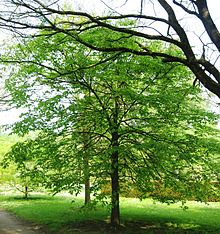Ulmus thomasii
| Rock elm | |
|---|---|
 |
|
| Rock elm, Meise. | |
| Scientific classification | |
| Kingdom: | Plantae |
| (unranked): | Angiosperms |
| (unranked): | Eudicots |
| (unranked): | Rosids |
| Order: | Rosales |
| Family: | Ulmaceae |
| Genus: | Ulmus |
| Species: | U. thomasii |
| Binomial name | |
|
Ulmus thomasii Sarg. |
|
 |
|
| Natural range of Ulmus thomasii | |
| Synonyms | |
|
|
Ulmus thomasii, the rock elm or cork elm, is a deciduous tree native primarily to the Midwestern United States. The tree ranges from southern Ontario and Quebec, south to Tennessee, west to northeastern Kansas, and north to Minnesota.
The tree was named in 1902 for David Thomas, an American civil engineer who had first named and described the tree in 1831 as Ulmus racemosa.
Ulmus thomasii grows as a tree from 15–30 m (50–100 ft) tall, and may live for up to 300 years. Where forest-grown, the crown is cylindrical and upright with short branches, and is narrower than most other elms. Rock elm is also unusual among North American elms in that it is often monopodial. The bark is grey-brown and deeply furrowed into scaly, flattened ridges. Many older branches have 3–4 irregular thick corky wings. It is for this reason the rock elm is sometimes called the cork elm.
The leaves are 5–10 cm (2–4 in) long and 2–5 cm (3⁄4–2 in) wide, oval to obovate with a round, symmetrical base and acuminate apex. The leaf surface is shiny dark green, turning bright yellow in autumn; the underside is pubescent. The perfect apetalous, wind pollinated flowers are red-green and appear in racemes up to 40 mm (2 in) long two weeks before the leaves from March to May, depending on the tree's location. The fruit is a broad ovate samara 13–25 mm (1⁄2–31⁄32 in) long covered with fine hair, notched at the tip, and maturing during May or June to form drooping clusters at the leaf bases.
...
Wikipedia
